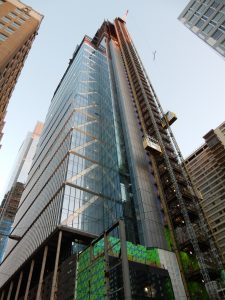 Norman Foster is building an office building in downtown Philadelphia. The Comcast Innovation and Technology Center, a 1,121-foot skyscraper, will be the tallest building in the city. Passing by the other day, I noticed elevator cabs scuttling up and down the side of the building. They reminded me of the external elevators on the Pompidou Center in Paris. Typical High Tech detail, I thought to myself, before I realized that these were construction elevators. The actual core is deep inside the building in the conventional fashion. And unlike Foster’s Hongkong & Shanghai Bank building, the structure is concealed as well (except for a vestigial expression of cross bracing on the otherwise pristine glass facade). Like almost all contemporary office buildings, in fact like almost all buildings of any kind today, this is a glass box. How times have changed! The truth is that the exposed structure and plumbing and ductwork that characterized High Tech architecture never made much sense. It weathered badly, for one thing—the Pompidou Center required an expensive facelift after only 20 years. The goal of infinitely adaptable architecture didn’t make sense either. The time-tested way to adapt is not to change a building but to move to another one. In 2014, the London Sunday Times reported that Lloyd’s was considering moving out of its headquarters building. It had already relocated a quarter of its operations to less expensive premises, and was subletting the space. The newspaper quoted Lloyd’s chief executive Richard Ward: “There is a fundamental problem with this building. Everything is exposed to the elements, and that makes it very costly.” Lloyd’s did not move, but it did sell the building to a Chinese insurance company (at a steep mark-down because of the inside-out design), and now leases space. So much for adaptive architecture. High Tech 0, Low Tech 1.
Norman Foster is building an office building in downtown Philadelphia. The Comcast Innovation and Technology Center, a 1,121-foot skyscraper, will be the tallest building in the city. Passing by the other day, I noticed elevator cabs scuttling up and down the side of the building. They reminded me of the external elevators on the Pompidou Center in Paris. Typical High Tech detail, I thought to myself, before I realized that these were construction elevators. The actual core is deep inside the building in the conventional fashion. And unlike Foster’s Hongkong & Shanghai Bank building, the structure is concealed as well (except for a vestigial expression of cross bracing on the otherwise pristine glass facade). Like almost all contemporary office buildings, in fact like almost all buildings of any kind today, this is a glass box. How times have changed! The truth is that the exposed structure and plumbing and ductwork that characterized High Tech architecture never made much sense. It weathered badly, for one thing—the Pompidou Center required an expensive facelift after only 20 years. The goal of infinitely adaptable architecture didn’t make sense either. The time-tested way to adapt is not to change a building but to move to another one. In 2014, the London Sunday Times reported that Lloyd’s was considering moving out of its headquarters building. It had already relocated a quarter of its operations to less expensive premises, and was subletting the space. The newspaper quoted Lloyd’s chief executive Richard Ward: “There is a fundamental problem with this building. Everything is exposed to the elements, and that makes it very costly.” Lloyd’s did not move, but it did sell the building to a Chinese insurance company (at a steep mark-down because of the inside-out design), and now leases space. So much for adaptive architecture. High Tech 0, Low Tech 1.
On Culture and Architecture

only really interesting building to come out in the last decade was the Leadenhall Building in London, across from Lloyd’s. The idea of the service core on the backside doubling as a structural anchor is innovative.